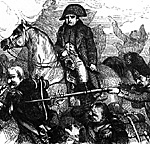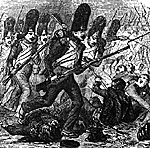 Note from Editor. We have here another updated reprint of an old EE&L article (EE&L 67, pp.11-12, October 1982) concerning the number of battalions of the Middle Guard attacking at Waterloo. The article was motivated by a reader challenging Paddy Griffith's statement in Forward into Battle that Napoleon launched an attack with 6 battalions of the Guard. The reader claimed:
Note from Editor. We have here another updated reprint of an old EE&L article (EE&L 67, pp.11-12, October 1982) concerning the number of battalions of the Middle Guard attacking at Waterloo. The article was motivated by a reader challenging Paddy Griffith's statement in Forward into Battle that Napoleon launched an attack with 6 battalions of the Guard. The reader claimed:
".... In truth, the route of the Imperial Guard at Waterloo is the most confused and disrupted action in all these wars. There is not even agreement as to which and how many battalions of the Guard were involved.... "
Indeed, the attack of the Middle Guard at Waterloo was a confused affair but the number of battalions and which battalions were involved is known if one takes the trouble to consult reliable French sources and Paddy Griffith was right. [1]
To determine the number of battalions involved in the attack we used two primary sources [2] and compared them with other reliable sources [3] using documents from the French Archives at Vincennes (returns, etc.). According to these sources, the battalions involved in the attack were:
So, we have 5 battalions all of which were part of the Middle Guard (6, if you count 2 battalions for the 4th Chasseurs).
We can safely claim that any narratives asserting otherwise or that a greater number of battalions took part in the attack are in error and misleading. Furthermore, it is easy to verify the above two sources by accounting for the location of all 14 battalions of the Old and Middle Guard present at Waterloo at the time of the attack.
At the time of the attack the remaining 9 Guard battalions were located as follows:
We believe the question to be resolved. We strongly recommend that the readership maintain an open mind and investigate what really took place by consulting some other sources reputed for their reliability. In investigating Waterloo, one must also consult reliable Belgian, Dutch, French and Prussian sources in addition to British sources.
If the reader thinks we exaggerate that many sources are in error and misleading, take a look at what follows.
As late as 1967, a historian [4] wrote the following in a footnote perpetuate the myth and mentions: "Authorities do not agree as to the number and identity of these battalions, nor do they see eye-to-eye on formations or the places struck. I have followed a consensus of opinion as to major details and my own conjectures in small matters."
So, here we have the state of mind of some historians who do not rely on primary sources, or sources from the other side.
"... The Duke from his position above Hougoumont saw through his telescope a single column of seven battalions of the Old and Middle Guard advancing one behind the other, each in a short column with a front of two companies. A six-company battalion so formed would have been 60 files broad by nine ranks deep. Close up tight - the expression then was "close column' - each battalion would have been only eight yards deep. But the battalions undoubtedly had their companies separated from each other by about either 24 or 12 yards, at 'half" or 'quarter distance' as it was called.... etc."
In our opinion, such narratives are unfortunate. Furthermore, the entire exercise on the space the 7-battalion formation occupied becomes an exercise in futility because there never were 7 battalions in the attack. In the end, one ends up with a gravely misleading narrative and a misrepresentation of the facts.
It is interesting to note that of the 21 battalions of the French Imperial Guard
Infantry at Waterloo, 12 are facing the Prussians, four are in Reserve behind La
Haye Sainte, and five are assaulting the center of the Anglo-Allied line between
Hougoumont and La Haye Sainte.
Source: Numbers drawn From Anthony Linck's Napoleon's Generals: The
Waterloo Campaign (see review in EE&L#10) based on his Archival
research at Vincennes.
More Waterloo
This article appears in MagWeb (Magazine Web) on the Internet World Wide Web.
(1) 1st battalion of the 3rd Grenadiers,
(2) the only battalion of the 4th Grenadiers
(3) the 2 battalions of the 3rd Chasseurs
(4) the 2 battalions of the 4th Chasseurs reduced to one battalion because of the losses suffered at Ligny.
(1) The 2nd battalion of the 3rd Grenadiers was posted by Napoleon between La Haye-Sainte and Hougoumont just before the attack.
(2) The 1st battalion of the 2nd Grenadiers and the 1st battalion of the 2nd Chasseurs were in Plancenoit.
(3) The 1st Grenadiers (2 battalions) were near the farm at Ransomme in squares, one on each side of the road.
(4) The 2nd Battalion of the 2nd Grenadiers, 2nd Chasseurs and 1st Chasseurs arrived near La Haye-Sainte as the battalions of the Middle Guard reached the British position (Napoleon was forming them into columns of attack).
 Then follows a lengthy discussion on the space such formation would have occupied and a discussion on the column advancing. In our opinion, such a discussion is fine as it tries to inform. However, there are several basic problems and the description ends up misleading and misinforming the reader on what took place because it is based on false assumptions:
Then follows a lengthy discussion on the space such formation would have occupied and a discussion on the column advancing. In our opinion, such a discussion is fine as it tries to inform. However, there are several basic problems and the description ends up misleading and misinforming the reader on what took place because it is based on false assumptions:
(1) A Guard battalion did not consist of 6 companies as the author leads us to believe but only included 4 companies.
(2) A Guard battalion never formed a column on a frontage of two companies but always a column of companies with a single company frontage.
(3) Where does the number of 7 battalions come from?
(4) Which source mentions a mixture of Old and Middle Guard battalions during the attack?
Footnotes:
[1] It has been always our contention that in order to get a true picture of what took place, one must consult the documents for the other side. It's what we did here. Many English language sources are in error because they did not take French sources into consideration. In addition, the Waterloo Letters can be a source of error and so can some French accounts.
[2] General Petit's report to be found elsewhere in this issue and Letter from Ney to the Duke of Otranto (26 June 1815).
[3] For instance, Scott Bowden Armies at Waterloo, Emperor Press.
[4] Weller Jac, Wellington at Waterloo, Thomas Y. Crowell Company New York, 1967. p.145.
Losses of the Guard Infantry Regiments Durig the
Waterloo Campaign Old Guard Regiments Original
25 June % losses
Location 1st Grenadier Regt (2)
1280 644
50% Square, Rossome 2nd Grenadier Regt
(2) 1091 374
66% 1 /2nd in Plancenoit
2/2nd La Haye Sainte1st Chasseur Regt (2) 1307 641
51% La Haye Sainte 2nd Chasseur Regt (2) 1263 244
81% 1/2nd in Plancenoit
2/2nd La Haye
SainteMiddle Guard Regiments Original
25 June % losses
Location 3rd Grenadier Regt (2) 1164 201
83% Final Assault;
2nd Battalion in reserve
behind La Haye Sainte4th Grenadier Regt (1) 520 100
81% Final Assault 3rd Chasseur Regt (2) 1062 165
84% Final Assault 4th Chasseur Regt (2, then 1) 1071 244
77% Final assault Young Guard Regiments Original
25 June % losses
Location 1st Tiralleur (2) 1109 92
92% Plancenoit 1st Voltigeur (2) 1219 196
84% Plancenoit 3rd Tiralleur (2) 988 164
83% Plancenoit 3rd Voltigeur(2) 967 146
85% Plancenoit
I: Attack of Middle Guard (Houssaye, 1815)
II: Attack of Middle Guard (Petit, 1815)
Number of Middle Guard Battalions
View of Middle Guard Attack
View of Middle Guard Illustration (Large: slow: 135K)
View of Middle Guard Illustration (Jumbo: monster: 1,133K)
What Really Happened at Waterloo?
Back to Empire, Eagles, & Lions Table of Contents Vol. 2 No. 13
Back to EEL List of Issues
Back to MagWeb Master Magazine List
© Copyright 1995 by Emperor's Headquarters
Other military history articles and gaming articles are available at http://www.magweb.com